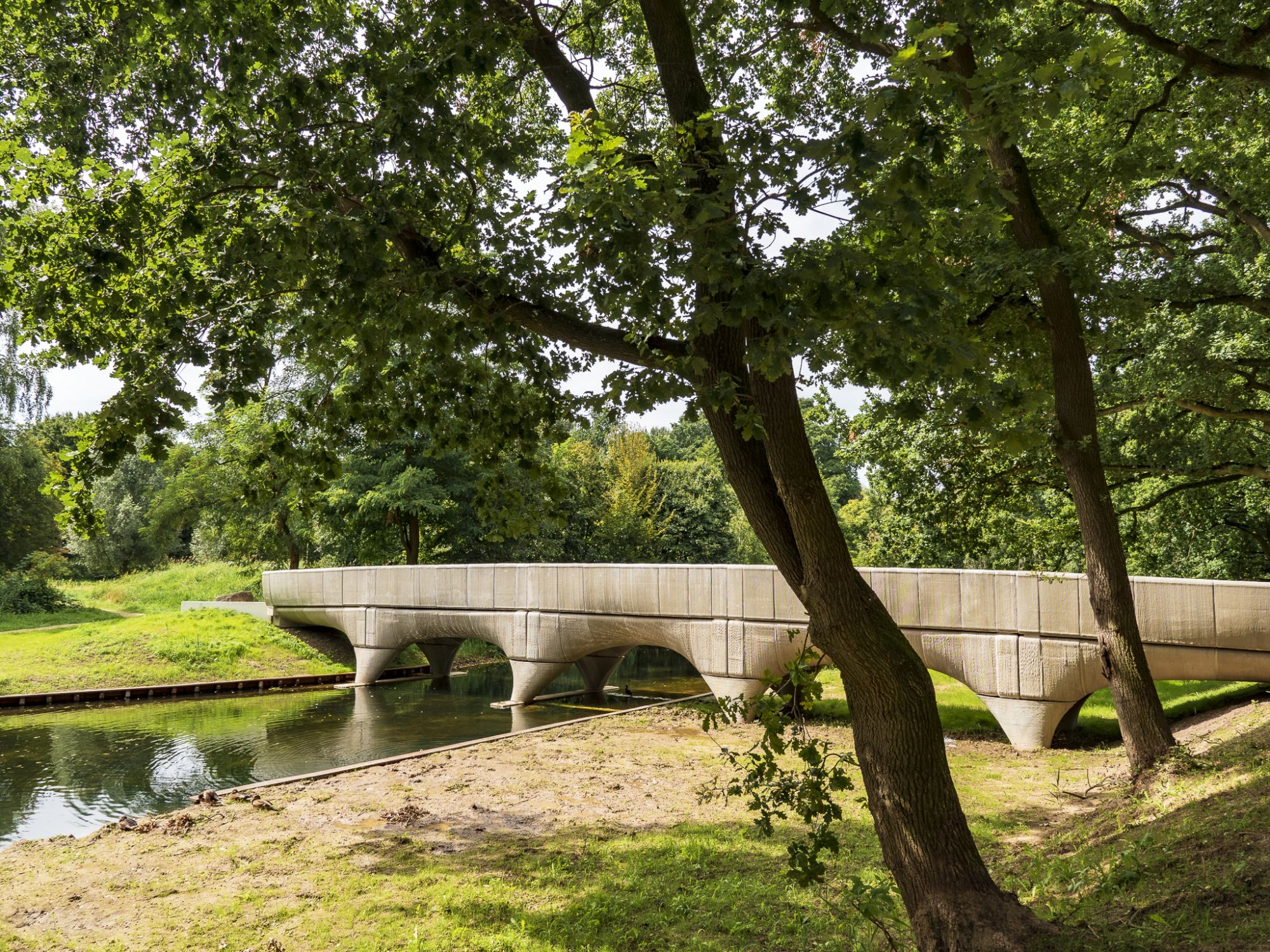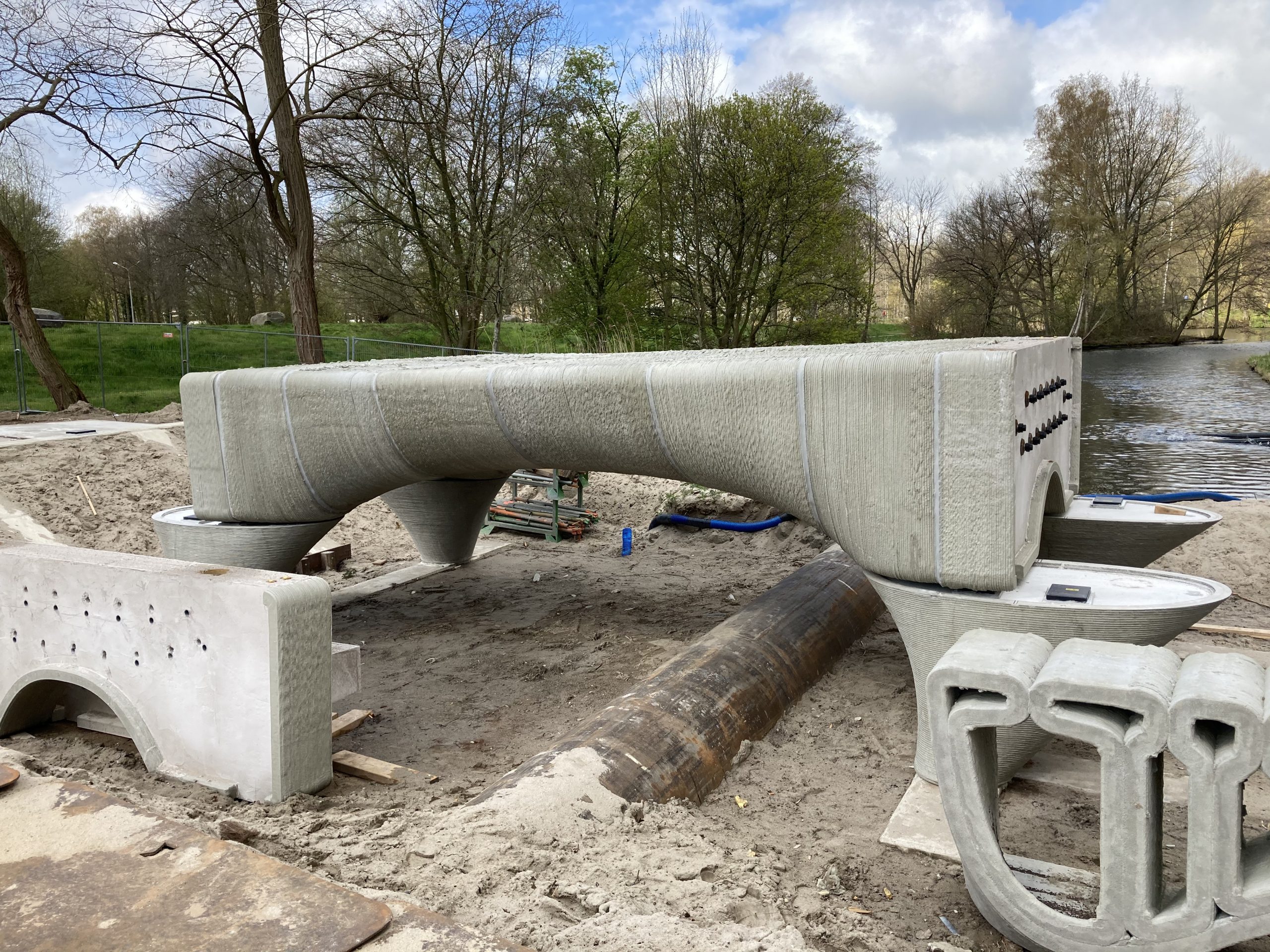The Dutch city of Nijmegen has unveiled what is reportedly the world’s longest 3D printed concrete pedestrian bridge, spanning a length of 29 meters.
The project was undertaken by Rijkswaterstaat, the Dutch Directorate-General for Public Works and Water Management, and designer Michiel van der Kley, in honor of Nijmegen’s election as a European Green Capital in 2018.
The partners turned to TU Eindhoven and consultancy and engineering firm Witteveen+Bos to help bring the 3D printed bridge to fruition, which was then manufactured by construction firms BAM and Weber Beamix in the latter’s concrete printing factory.
“The city of Nijmegen is very honored to receive this innovative 3D printed bridge,” said Alderman Bert Velthuis of Nijmegen City Council. “We are a city of bridges, and this special, innovative bridge is a wonderful addition. The bridge leads to connection: in the design and construction phase it connected the different partners, and from now on the bridge connects our residents.”

Freedom of design with AM
The partners first announced details of the bridge project back in April, and revealed their intention to break the world record for the longest 3D printed bridge which, until now, had been held by Tsinghua University for its 86-foot concrete bridge in Shanghai.
The project sought to utilize concrete 3D printing technology to provide van der Kley with complete freedom of form for the bridge’s design. Without being restricted by material choices or the limitations of traditional processes such as concrete formwork, van der Kley was able to design the bridge to absorb different forces in various places, while adding a more personalized touch.
To realize van der Kley’s vision, Witteveen+Bos translated the bridge’s design into 3D printable structural components. Based on this data, a parametric model created by Summum Engineering was then used to generate the final design of the bridge. The model conformed the original design to a set of structural constraints, segmented it based on printing specifications developed by TU Eindhoven, and generated an optimized internal geometry for the bridge.
“I found it especially important to show where we stand with 3D printing technology,” said van der Kley. “The design is inspired by a shape that arises in nature because it has to absorb a certain force in the most efficient way, and now translated into a digital process.
“With this shape we have made 3D printing of concrete objects more interesting again.”

Demonstrating sustainable construction techniques
The overriding aim of the project was to showcase the design and sustainability benefits of utilizing concrete 3D printing methods to produce not only bridges, but also houses and other buildings.
3D printed bridges can be constructed much faster than those built via conventional methods, and also require less concrete. It is these factors, according to the project partners, that makes concrete 3D printing technology an attractive technique for future construction projects in terms of sustainability and freedom of design.
“The printing of concrete has enormous growth potential,” said Theo Salet, Professor of Concrete Structures at TU Eindhoven. “We use less raw materials and can drastically increase the construction speed. In the future, we want to make concrete more sustainable and also reuse it. There is much more to achieve. I am also proud that the knowledge developed has found its way to the industry so quickly.”
Once the design of the bridge had been finalized, construction got underway at Weber Beamix’s concrete printing factory in Eindhoven. The bridge was printed using BAM’s concrete 3D printing technology, and was then assembled piece by piece on-site.
The bridge spans a total of 29 meters, reportedly taking the title of the world’s longest 3D printed concrete pedestrian bridge. The bridge was officially opened yesterday, 8th September.
“This 3D production technique delivers savings of up to 50 percent in materials, because the printer only deposits concrete where it is needed for structural strength,” added Bas Huysmans, CEO of Saint Gobain Weber Benelux. “3D technology is maturing and is becoming a serious option for faster, more sustainable and cheaper construction of, for example, bicycle and pedestrian bridges.”

3D printed bridge construction
Compared to conventional construction, concrete 3D printing yields substantial cost and lead time benefits, thus the technology is increasingly being used to build structures such as bridges, viaducts, and even commercial buildings.
As such, the technology has recently been deployed for several bridge building initiatives. One such project is being carried out by a consortium that includes building materials specialist LafargeHolcim and large-scale 3D printing firm XtreeE. The consortium has been tasked with designing and building a 40-meter pedestrian footbridge made from 3D printed structural concrete in Paris, in preparation for the 2024 Olympic Games.
More recently, ETH Zurich’s Block Research Group successfully 3D printed a concrete footbridge that required no steel or mortar reinforcement. Using significantly less concrete, the bridge was built by leveraging robotic 3D concrete printing to directly print the structural blocks.

Subscribe to the 3D Printing Industry newsletter for the latest news in additive manufacturing. You can also stay connected by following us on Twitter and liking us on Facebook.
Looking for a career in additive manufacturing? Visit 3D Printing Jobs for a selection of roles in the industry.
Subscribe to our YouTube channel for the latest 3D printing video shorts, reviews and webinar replays.
Featured image shows the “world’s longest” 3D printed concrete bridge in Nijmegen. Photo via Municipality of Nijmegen/Michiel van der Kley.



